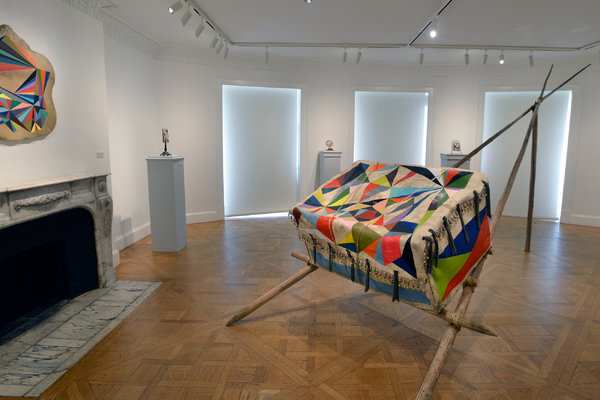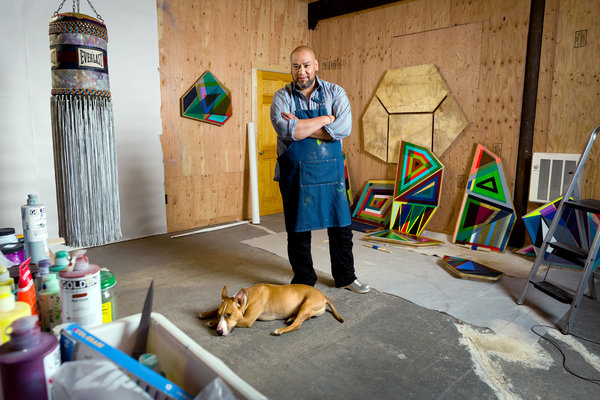Jeffrey Gibson Injects Visual Pizazz Into Found Objects

Karen Rosenberg, The New York Times
“Jeffrey Gibson: Said the Pigeon to the Squirrel” is the type of show that’s perking up the once-sleepy National Academy Museum. It inaugurates a new biennial program of solos by emerging artists, expanding on smaller efforts to highlight young, living artists (Phoebe Washburn’s spiraling nest of scrapwood in the rotunda, for example).
There are a few glitches with this one, however. One is that the Academy hasn’t yet figured out how to handle ultracontemporary art with the ease of a MoMA or a Whitney. (This show looks a lot like a commercial gallery exhibition, but its texts seem to be pitched at graduate students.) Another is that Mr. Gibson’s art, though promising, falls short of its potential.
Mr. Gibson, an abstract painter who often works on animal hides in homage to his American Indian heritage (he is a member of the Mississippi Band of Choctaw Indians and is half Cherokee), is certainly an interesting choice. His work points to worlds of intensive, disciplined art making beyond the walls of this Academy, or any academy.
It also embodies two sweeping trends in contemporary art: feverishly bright geometric abstraction and the creative reuse of found objects. The animal hides are stretched over antique mirrors and ironing boards, and even wrapped around fluorescent light tubes in an obvious nod to Dan Flavin.
In his catalog essay the show’s curator, Marshall N. Price, describes Mr. Gibson’s work as a “mash-up” or “remix.” The show’s playful title, he says, imagines a “dialogue between two urban animals as characters in a contemporary creation myth.”
Nonetheless, the paintings and their supports don’t always interact in any way that generates sparks. “Freedom,” for example, simply carries forward the indigenous conventions of the parfleche and the travois. (The parfleche is a carrying case made of animal hide, often adorned with geometric designs; the travois is a frame of long tepee poles, used to transport the parfleche on horseback.) Mr. Gibson’s version is exuberantly decorative, with beaded fringe and a weblike pattern of painted triangles, but then so are objects made and shown in a more traditional tribal context. A show last year at the gallery Participant made this point neatly with collaborations between Mr. Gibson and more specialized American Indian artists.
Other works — especially the ones made with antique mirrors as supports — have plenty of visual pizazz but are weak conceptually. The painting-as-mirror conceit feels a bit stale, and they rely too heavily on the thrift shop eclecticism of the mirrors, with their different carved and cast frames, to offset a formulaic painterly vocabulary.
Also problematic are the fluorescent light sculptures, which cover the bulbs with colored gel and encase them in acrylic tubes that are then wrapped in deer hide. On a material level, Mr. Gibson is onto something here: the hide softens the light, making the sculptures look less like Flavins and more like ravers’ glowsticks. But they still read as pastiches, especially if you aren’t aware of Mr. Gibson’s interest in rave culture.
He is certainly capable of variety and invention, as his drawings series “Infinite Sampling” suggests; its 55 configurations of pencil, watercolor, thread and tape have a kind of shamanic flow and intensity.
Something of that magic makes its way into the “shield paintings,” executed on hide stretched over ironing boards, which are by far the best of the painted works here. Their sharply angular compositions allude to European early Modernist movements, like Orphism and Rayism, but the curved contours of the boards foster all sorts of other associations: the surf-inspired art of 1960s Los Angeles, or the early shaped canvases of Frank Stella, or, as the titles suggest, heraldic armor.
Also intriguing are the punching bags bedecked with sequins, beads and tin shingles, wrapped in pieces of “repurposed” paintings. They have the festive, performative appeal of Nick Cave’s “Soundsuits”; one, “She Walks Lightly,” is placed close to an air-conditioning vent so that its fringed skirt sways ever so gently.
In the catalog Mr. Gibson recalls his inspiration for the piece: a performance by the dancer Norma Red Cloud. “She moved gracefully,” he writes, “so that the jingles all moved in unison and made the most beautiful sound: even, continuous, confident.”
The sculpture conveys that powerful impression and more, and suggests that dance — or movement of some kind — may be the next step for this talented artist who hasn’t quite hit his stride.
“Jeffrey Gibson: Said the Pigeon to the Squirrel” runs through Sept. 8 at the National Academy Museum, 1083 Fifth Avenue, at 89th Street; (212)369-4880, nationalacademy.org.


